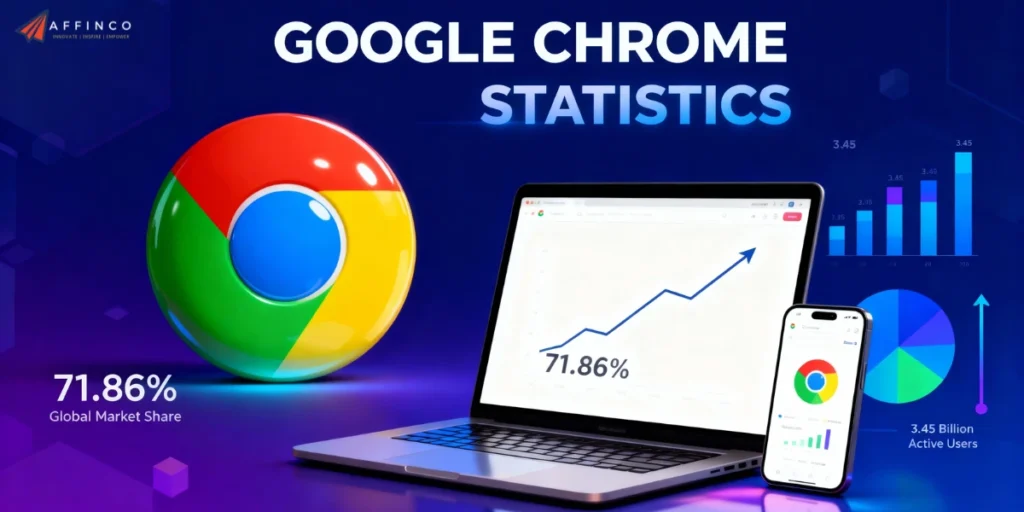
Google Chrome commands a powerful 67.72% browser market share with 3.83 billion users across the planet. In 2025, Chrome dominates mobile browsing at 68.34% while offering 111,000 extensions for endless customization possibilities.
We've researched and collected the freshest Google Chrome Statistics revealing exactly how this browser maintains its iron grip. From user demographics to South America's staggering 78.9% regional dominance, these numbers explain Chrome's unstoppable growth trajectory.
We've broken down every key metric from desktop usage and privacy habits to AI-powered features shaping the future of browsing.
Top Google Chrome Statistics 2025
Google Chrome's Global Market Share Dominance
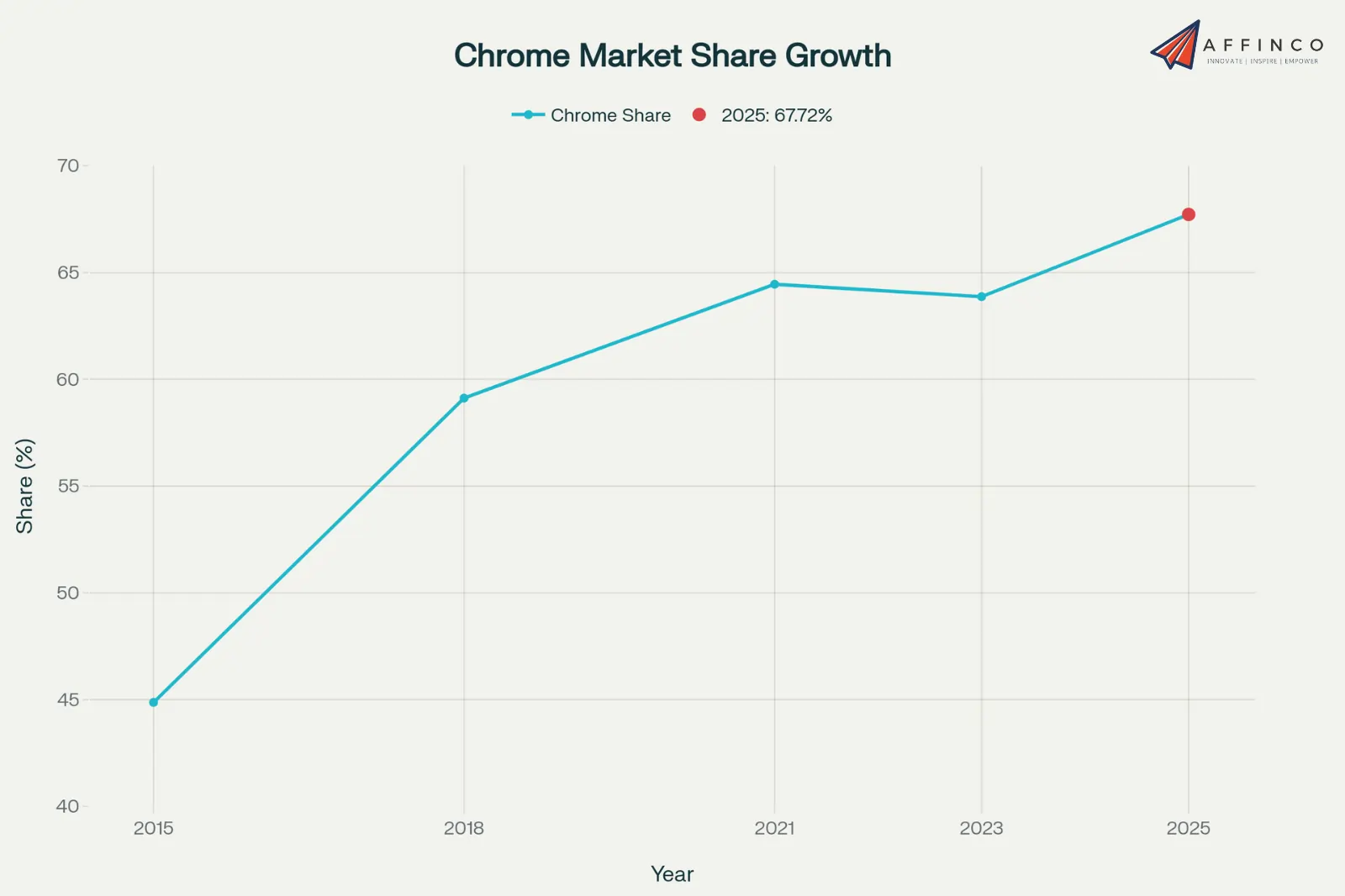
Chrome’s position as a market leader is clear from its substantial market share. It has consistently held the top spot for years, leaving competitors like Safari, Edge, and Firefox far behind.
As of 2025, Google Chrome's worldwide browser market share across all platforms is 67.72%. This figure shows a slight increase from previous years, solidifying its role as the market leader.
Its closest rival, Safari, holds only 16.64% of the market. Below is a table showing Chrome's market share growth over the years.
| Year | Market Share (%) |
|---|---|
| 2015 | 44.87 |
| 2018 | 59.12 |
| 2021 | 64.45 |
| 2023 | 63.87 |
| 2025 | 67.72 |
The data shows a consistent upward trend in Chrome's market presence over the last decade. This growth reflects its successful adaptation to user needs and technological changes.
Chrome's Market Share Across Devices
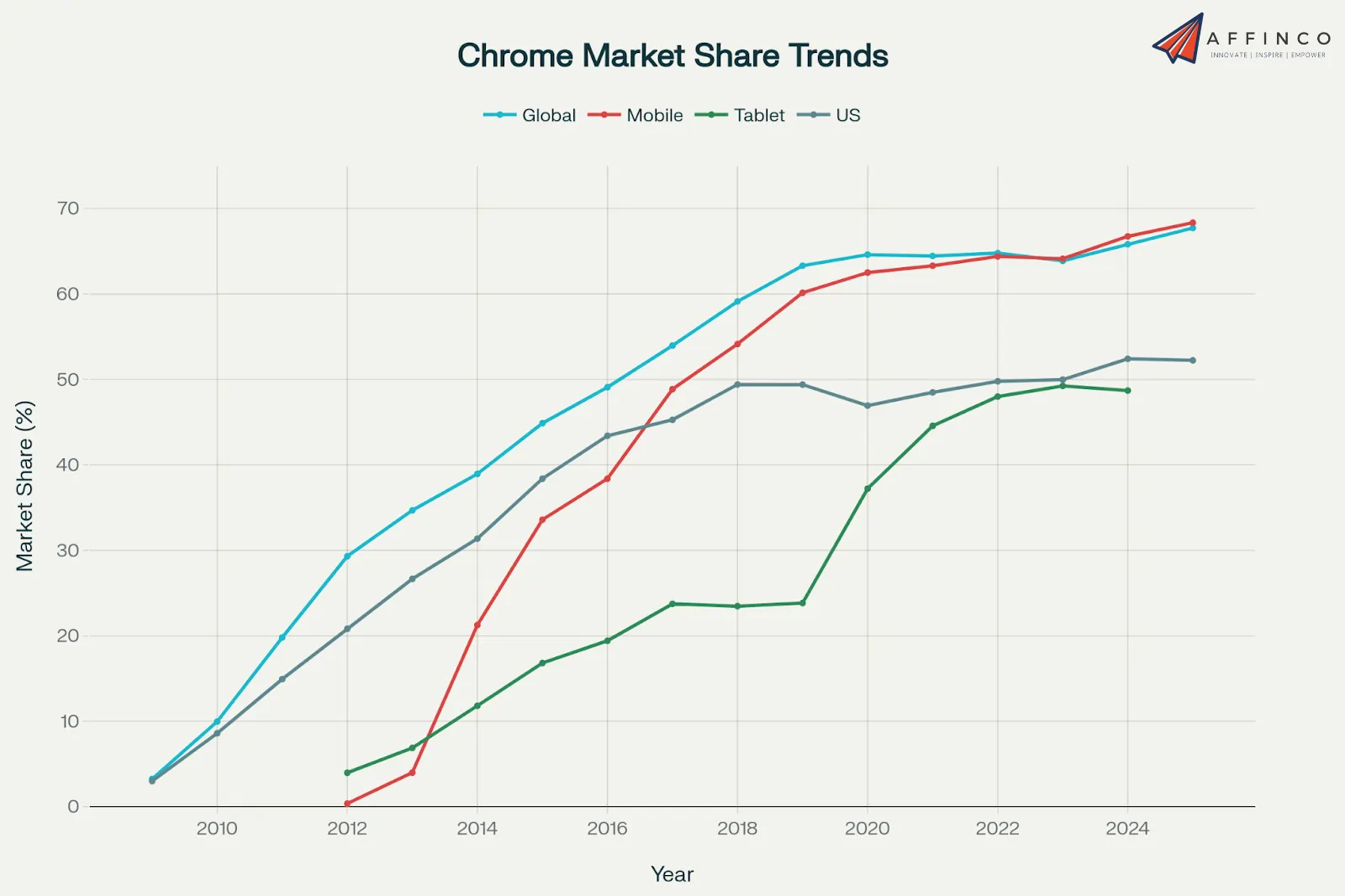
Chrome's market leadership varies when looking at different device types. While it leads across the board, its level of dominance changes between desktop, mobile, and tablet platforms.
This breakdown by device shows that while Chrome is the overall leader, its command is most significant on mobile phones. The tablet market remains a more contested area.
How Many People Use Google Chrome?
The number of people who use Chrome is immense, showing how deeply it is integrated into modern digital life. The browser's user count has grown steadily, reaching new heights in 2025.
Around 3.83 billion individuals use Google Chrome, which is a 5.8% increase from the previous year. Some analyses suggest the number could be as high as 3.98 billion. This user base has expanded significantly, growing from 1.25 billion in 2014.
| Year | Users (Billion) |
|---|---|
| 2018 | 2.39 |
| 2020 | 3.06 |
| 2022 | 3.3 |
| 2024 | 3.62 |
| 2025 | 3.83 |
This consistent expansion in the user base demonstrates Chrome's lasting appeal and its ability to attract new users. This growth is a key indicator of its continued relevance.
Chrome User Demographics: Who Uses the Browser?
Examining the demographics of Chrome users offers insights into who is driving its popularity. The data shows that the browser appeals most to younger internet users.
These demographics show that Chrome is particularly popular among young and middle-aged professional males. Its status as an essential tool for many highlights its importance in daily life.
Regional Chrome Statistics: A Global Perspective
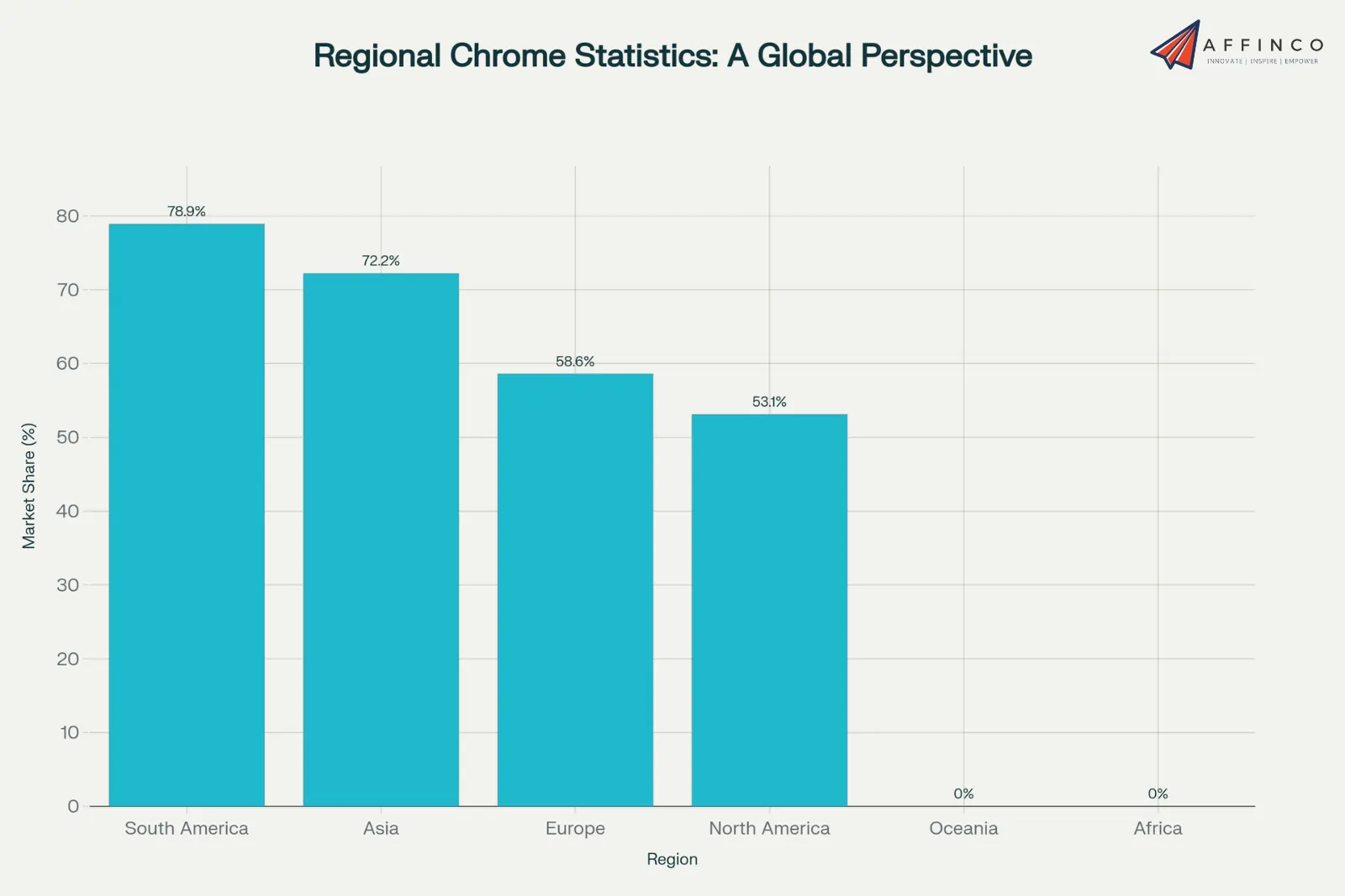
While Chrome is a global leader, its market share differs from one region to another. Its dominance is most pronounced in some parts of the world, while in others, it faces more significant competition.
The regional data shows that Chrome's global strategy has been highly effective, particularly in developing markets. However, in regions with strong local competitors, its lead is less substantial.
In-Depth US Market Analysis
The United States presents a unique market for web browsers, with different trends compared to global averages. While Chrome leads, its dominance is less pronounced due to strong competition.
In the US, Chrome has a 52.23% share of the browser market, a figure significantly lower than its global share of 67.72%. Apple's Safari is a major competitor, holding 30.6% of the US market.
| Year | Market Share (%) |
|---|---|
| 2015 | 38.38 |
| 2018 | 49.4 |
| 2021 | 48.48 |
| 2023 | 49.97 |
| 2025 | 52.23 |
On desktops, Chrome's share in the US is 62.08%, but on mobile, it is the second most popular browser with a 42.49% share, behind Safari's 50.18%. This highlights the impact of Apple's ecosystem on browser usage in the US.
The Chrome Web Store and Extension Ecosystem
Chrome extensions play a significant role in its popularity, offering users a way to customize their browsing experience. The Chrome Web Store provides a vast selection, but data shows a very uneven distribution of usage.
As of August 2024, there were 111,933 extensions available, a decrease from previous years, suggesting Google is curating the store more actively. A large majority of these extensions have a small user base.
| Number of Users | Number of Extensions |
|---|---|
| Less than 1,000 | 95,136 |
| 1,000 to 100,000 | 14,797 |
| More than 100,000 | 2,000 |
| More than 1 million | 242 |
The extension ecosystem is a ‘winner-take-all' market, where a few popular extensions account for most of the usage. This indicates that while variety is large, only a few add-ons achieve widespread adoption.
How People Use Chrome: Browsing Habits

Understanding how people interact with Chrome provides valuable insights into user behavior. These habits, from tab management to privacy feature usage, paint a picture of a typical user session.
The average Chrome user keeps about 10 tabs open simultaneously.
A regular browsing session on Chrome lasts for around six and a half minutes on average.
More than half of all Chrome users have installed at least one ad-blocker extension to improve their browsing experience.
These usage patterns show that users rely on Chrome for multitasking and value its convenience features like password management and cross-device sync. The popularity of ad-blockers and incognito mode also points to a growing awareness of online privacy.
Chrome's Performance and Speed Statistics
Browser speed and performance are critical for user satisfaction. While Chrome is known for its speed, it also has a reputation for being resource-intensive, particularly with memory usage.
Google has introduced several features to address these performance concerns and improve efficiency.
Users often face a trade-off between Chrome's extensive features and its impact on system resources. Google's ongoing efforts to improve performance aim to strike a better balance for a smoother user experience.
Chrome on Mobile: Android and iOS Statistics
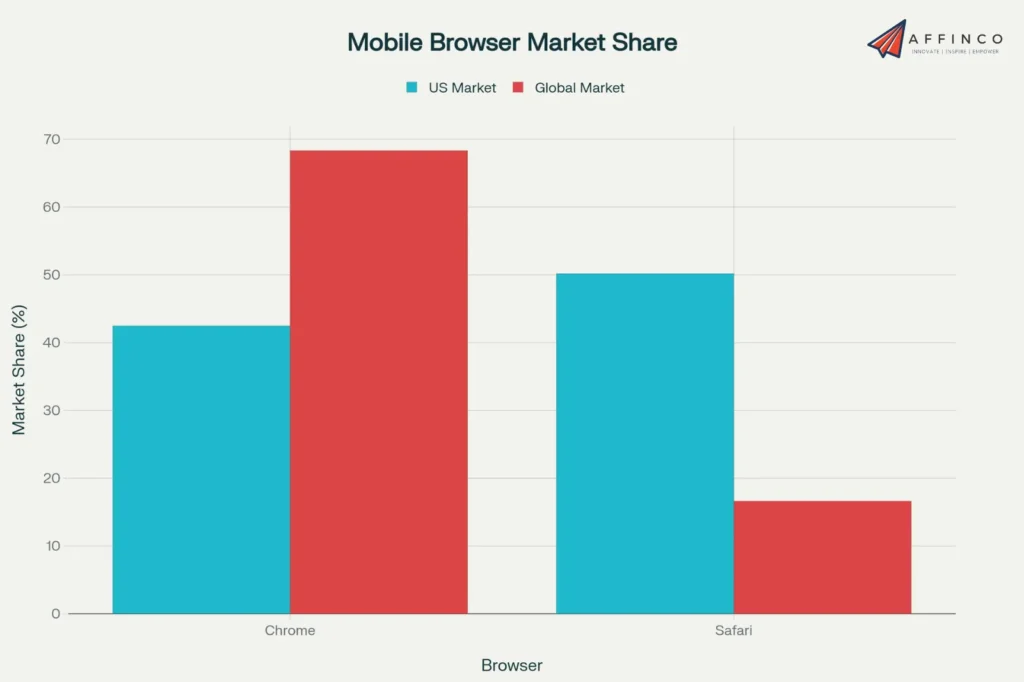
Chrome's presence on mobile devices is a cornerstone of its market dominance. Its performance on Android and iOS platforms, however, tells two different stories due to the nature of each operating system.
Chrome's global mobile browser market share stands at an impressive 68.34%. Its integration as the default browser on Android devices contributes significantly to this figure. The Google Chrome mobile app has achieved over 10 billion lifetime downloads on the Google Play store alone.
| Region | US Mobile Market Share | Global Mobile Market Share |
|---|---|---|
| Chrome | 42.49% | 68.34% |
| Safari | 50.18% | 16.64% |
In the US mobile market, the situation is reversed, with Safari leading due to the high adoption of iPhones. This shows that while Chrome is the global mobile leader, its position can be challenged in markets with strong hardware-software integration from competitors.
Google Chrome vs. Competitors: 2025 Showdown
While Google Chrome is the market leader, it operates in a competitive environment. Several other browsers offer unique features and cater to different user priorities, from privacy to customization.
Here is a comparison of the market shares of the top web browsers:
| Browser | Market Share (%) |
|---|---|
| Google Chrome | 67.72 |
| Safari | 16.64 |
| Microsoft Edge | 5.4 |
| Firefox | 2.9 |
| Opera | 2.7 |
Each browser has its own strengths, but Chrome's combination of speed, features, and integration with Google's ecosystem has allowed it to maintain a significant lead. The competition, however, ensures that all browsers must continue to improve.
The Integration of AI: Chrome's New Features for 2025

Google is incorporating Artificial Intelligence (AI) into Chrome, adding new capabilities that make the browser more of a smart assistant. These features are designed to improve organization, customization, and productivity.
These AI features show Google's direction for the browser's future. They aim to make browsing more intuitive and efficient, moving beyond simple web access to a more interactive experience.
Looking Ahead: Can Anyone Challenge Chrome’s Dominance?
Chrome's grip on browser dominance shows no signs of slipping, with 62.08% control on desktops and 50% of users trusting its built-in password manager. AI-powered features like tab organization and theme generation signal where browsing tech is headed next.
From 10 billion mobile downloads to extensions used by millions, Chrome keeps setting benchmarks competitors struggle to match.
For marketers, developers, and everyday users, understanding these patterns means staying ahead in a Chrome-first digital world. Will Safari or Edge finally crack Chrome's formula, or is 2026 just another year of Google's victory lap?

Ali
Ali is a digital marketing expert with 7+ years of experience in SEO-optimized blogging. Skilled in reviewing SaaS tools, social media marketing, and email campaigns, we craft content that ranks well and engages audiences. Known for providing genuine information, Ali is a reliable source for businesses seeking to boost their online presence effectively.








